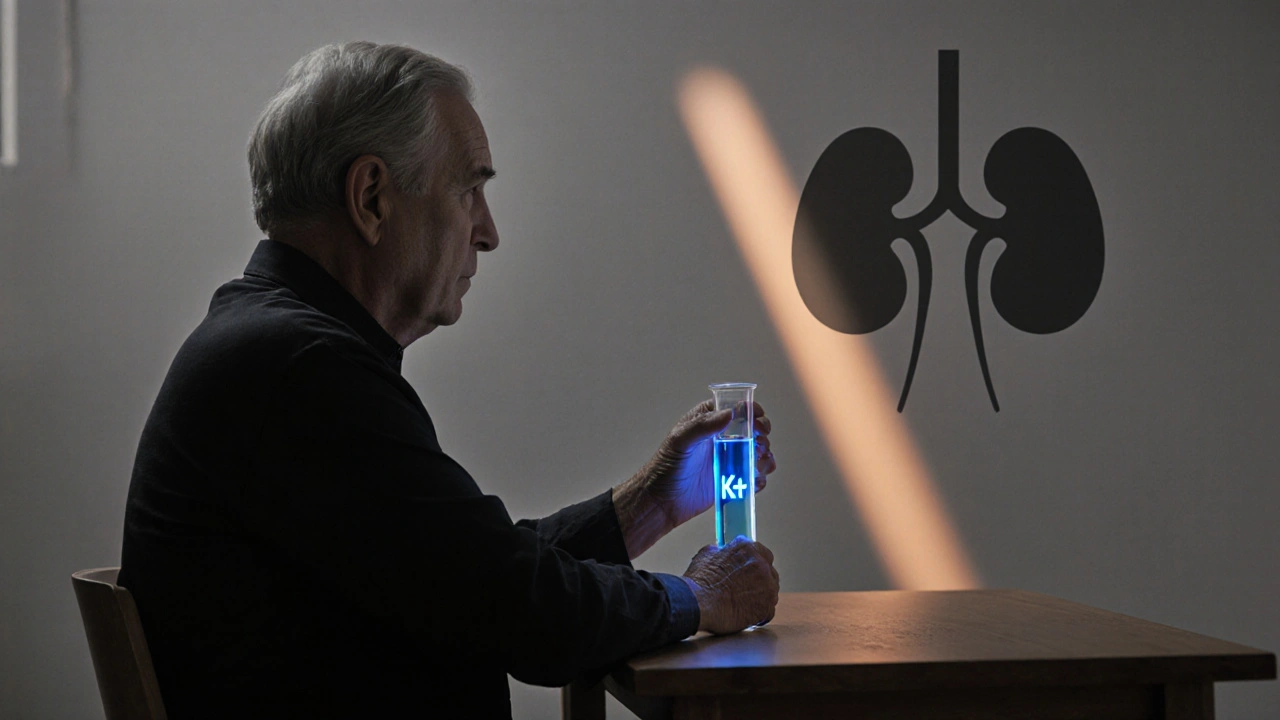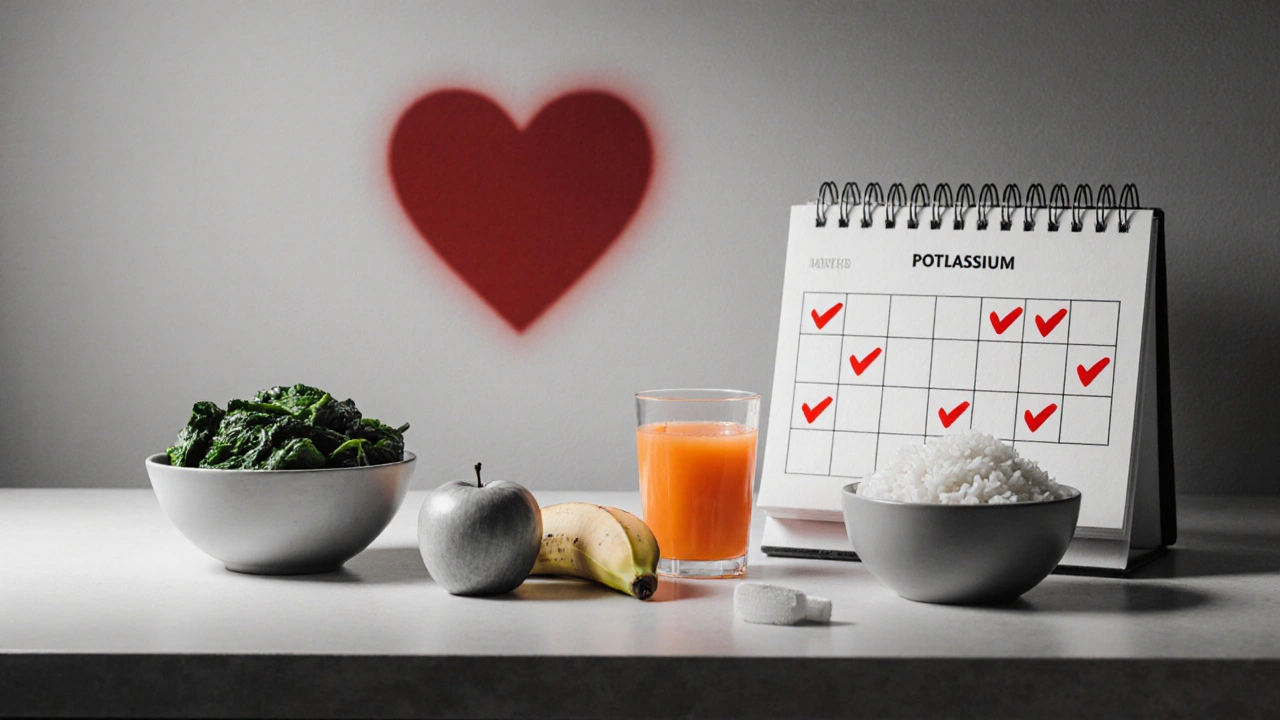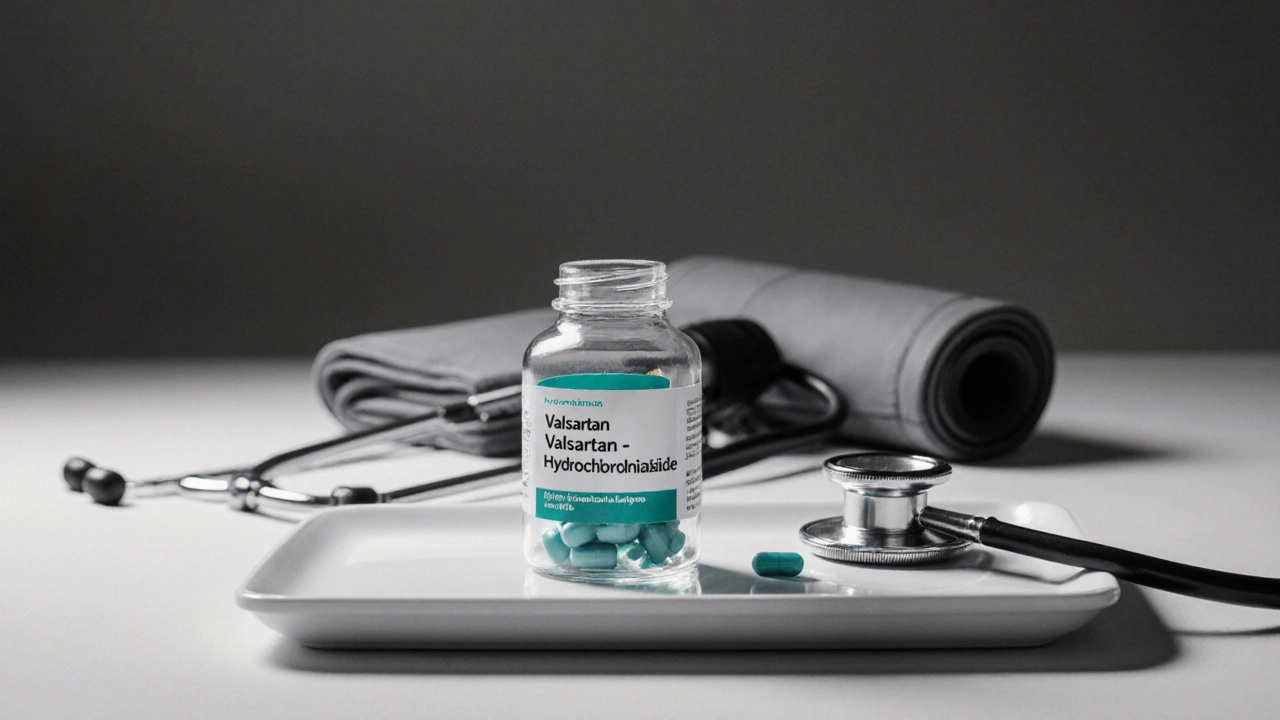Potassium Level Checker
Potassium Level Guide
When you’re prescribed Valsartan-Hydrochlorothiazide is a combined blood‑pressure pill that merges an angiotensinII receptor blocker (ARB) with a thiazide diuretic, you’re probably focused on lowering your numbers. What many patients overlook is how the thiazide part can tug at your body’s potassium balance, and why that matters for heart health.
Key Takeaways
- The ARB component protects potassium, while the thiazide component can lower it.
- Monitor blood potassium at least every 3-6 months, or sooner if you have kidney issues.
- Recognize symptoms of low (<3.5mmol/L) and high (> 5.0mmol/L) potassium.
- Adjust diet and meds under doctor guidance to stay in the safe 3.5-5.0mmol/L window.
What Valsartan-Hydrochlorothiazide Actually Does
Valsartan blocks the Renin-Angiotensin System, preventing blood vessels from tightening. Hydrochlorothiazide, a Thiazide Diuretic, tells the kidneys to dump more salt and water, which drops pressure but also nudges potassium out of the bloodstream.
How Potassium Levels Change
Potassium is the main intracellular cation that helps muscles, nerves, and the heart keep a steady rhythm. When a thiazide diuretic increases urinary loss, you can slide into Hypokalemia (low potassium). In contrast, the ARB side can blunt that drop, sometimes even pushing levels slightly higher, especially if you have reduced Kidney Function.
Normal Ranges and What They Mean
| Serum Potassium (mmol/L) | Classification | Typical Symptoms | Urgency |
|---|---|---|---|
| <3.5 | Hypokalemia | Muscle weakness, cramping, arrhythmias | Monitor, may need supplements |
| 3.5 - 5.0 | Normal | None | Routine check |
| >5.0 | Hyperkalemia | Nausea, tingling, dangerous heart rhythm changes | Immediate medical review |
If your result reads above 5.0mmol/L, you’re entering Hyperkalemia, a condition that can quickly affect heart rhythm and requires prompt medical review.

Who’s at Higher Risk?
- Patients with chronic kidney disease (Kidney Function impairment).
- Those taking other potassium‑affecting drugs such as ACE Inhibitors or potassium‑sparing diuretics.
- Elderly individuals who may have reduced dietary intake.
- People on a very low‑sodium, high‑potassium diet.
Practical Steps to Keep Potassium in Check
- Get a baseline serum potassium test before starting the combo.
- Schedule follow‑up labs every 3-6 months, or sooner if you develop symptoms.
- If potassium dips below 3.5mmol/L, discuss potassium‑rich foods (bananas, avocados, orange juice) or a low‑dose supplement with your doctor.
- If levels climb above 5.0mmol/L, your provider may lower the thiazide dose, add a potassium‑binding resin, or temporarily pause the medication.
- Maintain adequate hydration but avoid excessive fluid loss from vigorous exercise without electrolyte replacement.
Dietary Ideas
Here are everyday foods that can help you fine‑tune potassium without overdoing it:
- One medium banana (~420 mg potassium)
- ½ cup cooked spinach (~420 mg)
- 1 cup orange juice (~470 mg)
- ¼ cup raisins (~300 mg)
- One small baked potato with skin (~610 mg)
If you need to raise potassium, aim for 2-3 of these servings a day. To lower it, cut back on the higher‑potassium items and favor lower‑potassium choices like apples, berries, and white rice.

When to Call Your Healthcare Provider
Don’t wait for a routine lab if you notice any of these red flags:
- Sudden muscle aches or twitches
- Rapid heartbeat, palpitations, or dizziness
- Severe nausea or vomiting
- Unexplained fatigue that interferes with daily tasks
These could signal that your potassium has moved out of the safe zone and needs immediate attention.
Common Misconceptions
My doctor said the ARB part protects my potassium, so I don’t need to worry. The ARB does reduce the risk, but the thiazide can still cause a measurable drop, especially in people with borderline levels.
“I can take over‑the‑counter potassium supplements whenever I feel off.” Not a good idea. Supplement dosage varies, and excess potassium can trigger life‑threatening arrhythmias.
Bottom Line
Valsartan‑Hydrochlorothiazide is a powerful pair for controlling blood pressure, but its impact on potassium means you need regular labs, a balanced diet, and awareness of symptoms. By staying proactive, you keep both your heart and kidneys happy.
Frequently Asked Questions
Can Valsartan-Hydrochlorothiazide cause low potassium?
Yes. The hydrochlorothiazide component increases urinary potassium loss, which can lead to hypokalemia, especially in people with kidney issues or those on a low‑potassium diet.
How often should I have my blood potassium checked?
At the start of therapy, then every 3-6 months. If you develop symptoms or have chronic kidney disease, your doctor may schedule tests more frequently.
What foods should I eat to raise my potassium?
Bananas, oranges, potatoes with skin, spinach, and dried fruits are rich sources. Aim for 2-3 servings daily if your lab shows low potassium.
Is it safe to take potassium supplements with this medication?
Only under a doctor’s supervision. Too much potassium can cause hyperkalemia, which is dangerous for heart rhythm.
Can I stop the drug if my potassium is low?
Do not stop abruptly. Your provider may lower the dose, switch to a different diuretic, or add a potassium‑sparing agent instead.






Chris Meredith
October 15, 2025 at 21:31
Hey folks, just wanted to throw some extra insight on the Valsartan‑Hydrochlorothiazide combo – think of it as a double‑edged sword for electrolytes. The ARB side acts like a potassium‑saver, while the thiazide part is a renal‑potassium excretor, so you can swing between hypokalemia and normokalemia depending on renal function and diet. If you’re on a low‑potassium regimen, you’ll want to schedule that baseline serum K+ draw before the first dose and then repeat every 3‑6 months. Keep an eye on any muscle cramps or palpitations; they’re early flags that the potassium balance might be drifting. And remember, a simple dietary tweak – a banana or a splash of orange juice – can often keep you comfortably in the 3.5‑5.0 mmol/L window without needing a prescription supplement.